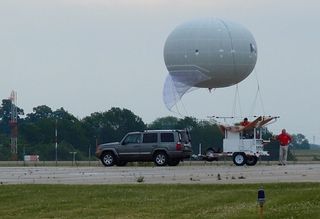Tethered Blimps Could Be Legal Alternative to Drones

A company that makes tethered blimps for the military is now developing them for commercial uses, from surveillance of bridges and roadways to assistance after natural disasters.
Free-flying drones, or unmanned aircraft systems, have also been proposed for these purposes, but the U.S. Federal Aviation Administration (FAA) has yet to complete writing its regulations for drones, with official rules expected no sooner than 2015.
In the meantime, the "blimp-in-a-box" system, as it's called, could perform many of the same functions as drones, and does not need FAA approval, Drone Aviation Corp. representatives said. These tethered blimps are also cheaper and safer to use, according to the company. [5 Surprising Ways Drones Could Be Used in the Future]
The technology was originally developed for the U.S. Department of Defense, but its makers realized there were a lot of potential commercial applications, said Dan Erdberg, chief operating officer for Drone Aviation Holding Corp. "We believe there's a tremendous opportunity for these systems in security," Erdberg told Live Science.
The tethered blimps can fly at a range of up to 500 feet (150 meters), and don't require FAA authorization because they are tethered. They can operate for between 24 to 36 hours before they need to come down — much longer than any commercially available drone, Erdberg said.
The vehicles can be equipped with HD cameras that can see a person or vehicle up to 3 miles (4.8 kilometers) away, in daytime or nighttime, and can also carry a radio communication system.
The blimps come in various sizes, ranging from miniature systems that can be mounted on the back of an all-terrain vehicle to larger systems pulled behind a Humvee or pickup truck. The balloons, which are inflated with helium, can be deployed in the air within 10 to 15 minutes. The vehicles can even drive around while the blimp is airborne, company representatives said.
Sign up for the Live Science daily newsletter now
Get the world’s most fascinating discoveries delivered straight to your inbox.
The Ohio Department of Transportation recently ordered one of the blimps to use for aerial surveillance, andthe Nashville Police Department is already using a similar system for monitoring large crowds at concerts, sporting events and the state fair. The blimp could also be used to search for survivors after natural disasters, Drone Aviation Corp. representatives said.
The floating aircraft are safer than vehicles currently used for commercial surveillance, such as helicopters, Erdberg said. Because they're tethered, the balloons are easy to control, and don't represent a hazard to buildings or other aircraft. They can't be hijacked or "go haywire" mechanically, he added.
In addition, the lighter-than-air vehicles are less costly to acquire and operate. Flying a blimp costs less than $20 per hour, Erdberg said. The entire system costs between less than $100,000 to $300,000, depending on the components (especially the camera).
For that price tag, privacy concerns aren't an issue, Erdberg said. Your neighbor's not going to be able to buy one and fly it over your house, he said.
Follow Tanya Lewis on Twitter and Google+. Follow us @livescience, Facebook & Google+. Original article on Live Science.

